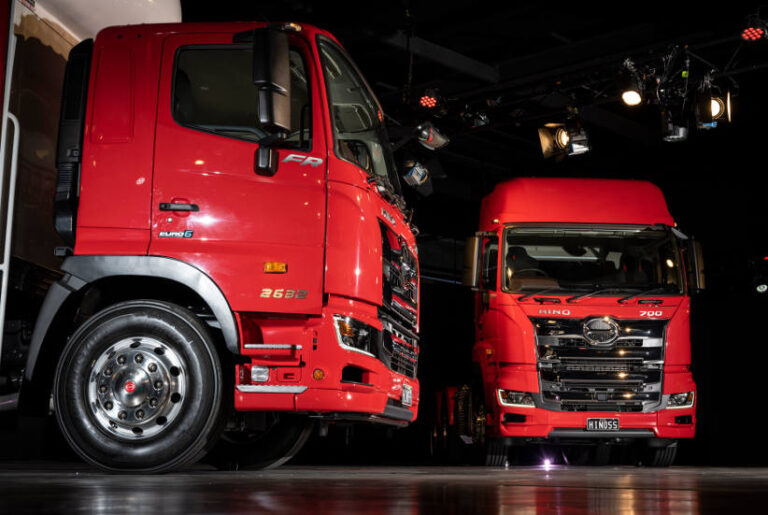When Australia shifts to Euro 6 emissions standards in 2025, Hino Australia is preparing for a significant update across its model range, including temporary gaps in availability for specific models. Fleet managers considering vehicle replacements over the next two years should be aware of these supply shifts, which may affect long-term fleet planning and replacement cycles.
For fleets prioritising emissions reductions, the changeover offers an added benefit: Hino’s 300 Series will be available exclusively in hybrid electric for a period of time, providing a low-emission option in the light-duty category. Here’s what fleet managers need to know about the impact of Euro 6 on Hino’s model availability, supply timelines, and opportunities to plan ahead.
Preparing for Euro 6: Model availability and supply gaps
As Hino transitions to Euro 6 emissions standards, some models in the 300 and 500 Series will experience gaps in availability, a common occurrence as manufacturers retool and update production lines. While this process is necessary to meet regulatory standards, it does mean that certain models will be temporarily unavailable in Australia, impacting the timing of new vehicle orders for many fleet managers.
- 300 Series diesel
The Hino 300 Series diesel model will be available only through early 2026. After this, there will be a gap in diesel production until later that year, when the Euro 6-compliant model becomes available. During this period, Hino’s 300 Series lineup will consist solely of hybrid electric models. This exclusive availability of hybrid models offers an opportunity for fleet managers interested in reducing their fleets’ emissions footprint, as the hybrid option is a practical way to cut emissions without waiting for the diesel model’s return. - 500 Series diesel
For the Hino 500 Series, the supply gap will be more extended. While current orders for the 500 Series will be fulfilled into late 2025, there will be a significant gap in diesel model availability until late 2026, when the Euro 6 version arrives. This 10-month production pause will require fleet managers to carefully review their replacement cycles to avoid operational disruptions.
Planning replacement cycles: Key considerations
Fleet managers aiming to maintain a seamless vehicle replacement cycle will need to consider several approaches to accommodate the upcoming gaps. For those with diesel models in the 300 and 500 Series currently approaching end-of-life, early replacement is one option, allowing fleets to secure diesel models before production pauses. Alternatively, for fleets that are able to extend the service life of current vehicles, deferring replacement until Euro 6 stock arrives may also be viable, particularly if hybrid models do not meet specific operational needs.
- Early replacement
To avoid potential supply issues, fleet managers may choose to bring forward vehicle replacements planned for 2025. Placing orders early ensures that vehicles can be delivered before the production gap takes effect, helping fleets maintain standard operating cycles. - Extended use of existing vehicles
For fleets willing to extend vehicle life until Euro 6 models are available, reviewing maintenance needs and preparing for additional servicing will be essential. While this approach can be cost-effective, it requires careful planning to avoid unexpected downtime. - Adopting Hybrid Electric models in the 300 Series
For fleet managers focused on sustainability, Hino’s exclusive hybrid offering in the 300 Series during the gap period presents an effective way to manage vehicle needs while reducing fleet emissions. The 300 Series hybrid model is suited to urban delivery and light-duty applications, and adopting this powertrain may allow fleets to meet both operational and environmental objectives.
Benefits of Hybrid Electric in the 300 Series
For fleet managers focused on reducing emissions, the temporary availability of only hybrid electric models in the 300 Series represents a timely opportunity. Hino’s hybrid technology delivers lower fuel consumption and reduced greenhouse gas emissions compared to traditional diesel engines. With rising interest in emissions reduction strategies across industries, the hybrid 300 Series is a practical solution for fleets looking to minimise environmental impact without transitioning entirely to electric.
The hybrid 300 Series also offers financial benefits for fleets, including potential fuel savings and eligibility for government incentives focused on low-emission vehicles. Additionally, as the industry moves toward increased adoption of low-emission technology, integrating hybrids can serve as a stepping stone, preparing fleets for future transitions to fully electric vehicles.
Hino’s commitment to a sustainable future
Hino’s move to Euro 6 emissions standards and increased hybrid offerings reflects a broader commitment to sustainability. The company aims to position itself as a leader in low-emission solutions, ensuring that fleets have access to both advanced technology and regulatory compliance. For fleet managers, these options mean a pathway toward greener, more efficient operations that align with evolving environmental standards.
Next steps for Fleet Managers
As Hino prepares to bring Euro 6 models to market, fleet managers should consider the implications for their vehicle replacement cycles. The gaps in 300 Series diesel and 500 Series availability present both challenges and opportunities, allowing fleets to explore hybrid technology, bring forward replacement cycles, or extend vehicle life as needed. By planning ahead, fleet managers can mitigate the impact of these production shifts and position their fleets to benefit from Hino’s enhanced, low-emission model lineup once Euro 6 models become available.
With thoughtful planning, the Euro 6 transition can support fleet goals for sustainability, efficiency, and resilience in an evolving industry landscape. Hino’s upcoming changes offer fleets a chance to align with cleaner technologies and prepare for a future that increasingly prioritises environmental responsibility.






